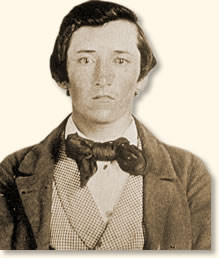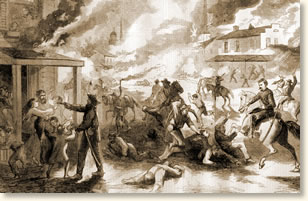|
William Quantrill Raids
Lawrence, Kansas, 1863
Unlike other areas of the nation during the Civil War in which massed armies collided on the battlefield, the fighting along the Kansas-Missouri border took the form of a bloody guerilla war. The conflict was an extension of the bitter rivalry between the pro-slavery settlers of Missouri and the anti-slavery settlers of the neighboring Territory of Kansas on the other side of the Missouri River. The new settlement of Lawrence, Kansas was at the epicenter of this fire-storm of violence. A hub of anti-slavery activity, the town had been sacked in 1856 by raiders from Missouri (see The Sack of Lawrence, Kansas, 1856) and eight years later was the target of one of the most vicious and bloody encounters of the Civil War. William Clarke Quantrill led this attack.
 |
William Quantrill
|
William Quantrill came to Kansas in 1859 and found employment as a school teacher. However, his past history of horse theft and murder soon caught up with him and he was forced to seek safe-haven across the Missouri River in Missouri. With the outbreak of war, Quantrill organized a small band of raiders that launched hit-and-run raids into Kansas. Within its ranks were a number of future legendary outlaws who, after the Civil War, used the tactics they learned from Quantrill to rob banks and other rich targets. Among Quantrill's protégés were Jesse James, his brother Frank, Cole Younger and his brother Jim.
The "high point" of Quantrill's guerilla war came on August 21, 1863 with the raid on Lawrence. Leading as many as 450 raiders, Quantrill sacked the town of Lawrence and left as many as 183 dead in his wake. Many of these hapless victims were dragged from their dwellings and murdered in front of their families. Their home was then put to the torch. Quantrill and his band then slipped back across the Missouri River into Missouri.
Retribution was swift. Union soldiers forced the Missouri residents along the Missouri River to flee their homes which were then pillaged and set ablaze.
“The troops then dashed back up into the town, down the main street, shooting at every blue coat that came in sight.”
John McCorkle rode with Quantrill's raiders for three years and served as his scout. His experiences were published as a book in 1914. McCorkle took part in Quantrill's raid on Lawrence, Kansas. We join his story during the early morning hours of the day of the raid:
"...on arriving here on the night of the 17th instant,I learned that a party
of
insurgents, about 11pm on the 16th, had seized the watchmen stationed at the
armory, arsenal, rifle factory, and bridge across the Potomac, and taken possession
of those points.
On the morning of the 20th of August, Quanntrell gave the order to break camp and march in a southwesterly direction, and went over on the Big Blue to a point south of Little Santa Fe, a town just on the Kansas line. His entire march until he reached the Kansas line was through smoking ruins and blackened fields. He halted in the woods all day and just about dark he gave the order to mount and crossed into Kansas at a point about ten miles south of Little Santa Fe and turned directly west toward the town of Lawrence, and, riding all night, the town was reached just at daylight.
At the entrance to the town, there were a lot of tents in which were camped a detachment of negro soldiers and a few white men. The command halted here and someone fired a shot. Immediately the negroes and white men rushed out of their tents, the majority of them starting in the direction of the river and some going in the direction of town. The command was given to break ranks, scatter and follow them. A few of the negroes reached the river, plunging into it, but none succeeded in reaching the opposite shore.
 |
The Raid on Lawrence
|
The troops then dashed back up into the town, down the main street, shooting at every blue coat that came in sight. Just before entering the town Colonel Quantrell turned to his men and said, "Boys, this is the home of Jim Lane and Jennison; remember that in hunting us they gave no quarter. Shoot every soldier you see, but in no way harm a woman or a child." He dashed ahead of his command down Main Street, firing his pistol twice, dismounted from his horse and went into the hotel, where he was met by the landlord, whom he recognized as an old friend and immediately gave orders for the landlord not to be molested and stayed in the hotel and guarded him.
During all this time, his command were [sic] busy hunting men with blue clothes and setting fire to the town. Jim Lane and Jennison were the ones wanted and some of the boys dashed at once to Jim Lane's house, but, unfortunately for the world, did not find him. They found his saber, which was very handsome, the scabbard being heavily gold-plated. In the parlor of Lane's house, there were three pianos and the boys recognized two of them as having belonged to Southern people in Jackson County, and a great many other things belonging to Southern people were found in his house.
Quantrell remained in Lawrence about two hours and when he left, the town was in ashes and 175 Jayhawkers were dead. Lane and Jennison had made desolate the border counties of Missouri, pillaged and burned homes murdered Southern men, Insulted, outraged and murdered the wives and sisters of these men. Quantrell and his command had come to Lawrence to be avenged and they were. In this raid, a few innocent men may have been killed but this was not intentional.
References:
This eyewitness account appears in: Barton, O.S., Three Years with Quantrell: A True Story Told by his Scout John McCorkle (1914, republished 1966),
How To Cite This Article:
"William Quantrill Raids Lawrence, Kansas, 1863" EyeWitness to History, www.eyewitnesstohistory.com (2010).
|






